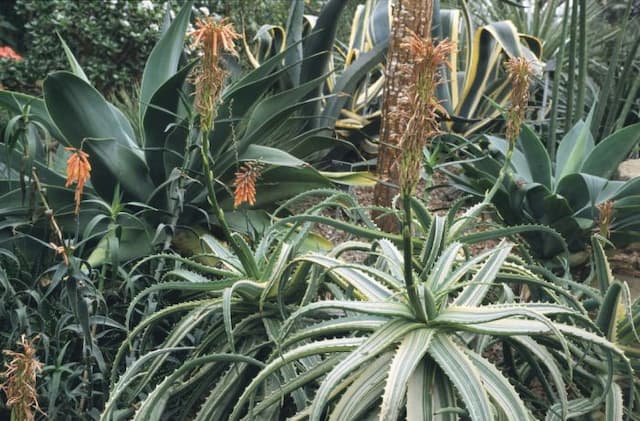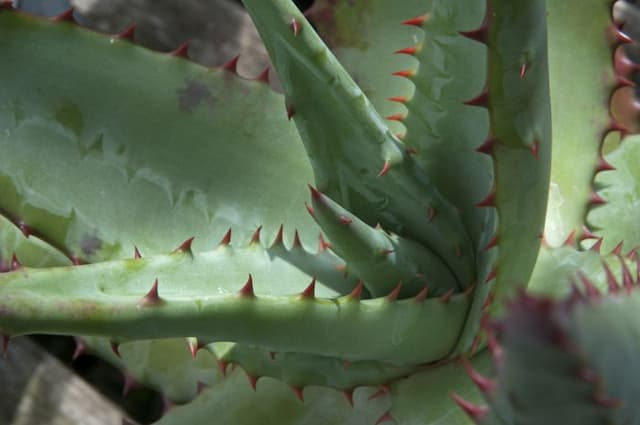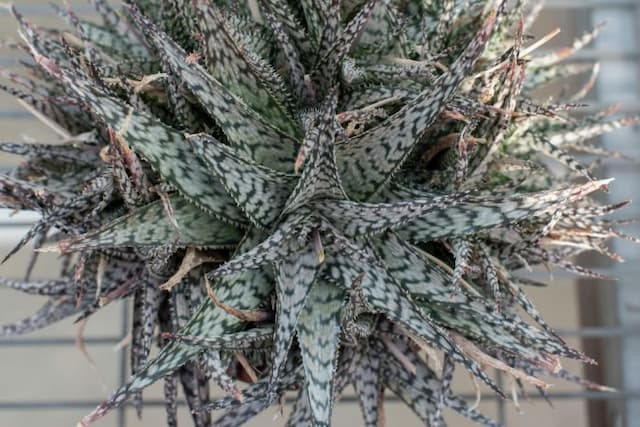Red hot poker Kniphofia rooperi

ABOUT
The plant commonly known as the Red Hot Poker displays a stunning and hard-to-miss appearance typical of its name, characterized by its fiery-hued flower spikes. These vibrant blossom spikes brandish a gradient of colors ranging from warm yellow at the bottom to a rich, intense red at the top, resembling a torch or poker that is ablaze. The flowers are tubular in shape and densely packed in clusters along the upright and towering floral spikes, drawing a buzz of pollinators like hummingbirds and bees. The foliage of the Red Hot Poker forms a lush, grassy base from which the flower spikes emerge. The leaves are long and slender, with a slightly arching habit, and a deep green color that provides a striking contrast to the bold colors of the blooms. The plant maintains a clump-forming growth pattern, which creates a dense tuft of foliage at the ground level. The overall impression of the Red Hot Poker is one of vibrant, dramatic beauty that can serve as a focal point in garden beds and borders, attracting attention and adding an exotic flair to the landscape.
About this plant
 Names
NamesFamily
Asphodelaceae
Synonyms
Rooper's Red-hot Poker, Rooper's Torch Lily
Common names
Kniphofia uvaria var. rooperi (Masters) Baker, Tritoma rooperi Masters.
 Toxicity
ToxicityTo humans
The plant commonly known as Red hot poker is not widely known for being poisonous to humans. However, like many plants, it is not intended for human consumption. If ingested, it may cause mild stomach upset, nausea, or diarrhea, but such reactions are relatively rare and generally limited to instances where a substantial amount of the plant is consumed. There is no significant data suggesting that Red hot poker poses a serious threat of toxicity to humans. If any part of the plant is ingested and symptoms appear, medical advice should be sought.
To pets
Red hot poker is generally not considered highly toxic to pets. However, it may cause mild gastrointestinal upset if ingested by pets, symptoms of which could include vomiting and diarrhea. As with any non-food plant, ingestion should be avoided, and if a pet does consume parts of a Red hot poker, monitoring for adverse reactions and consulting with a veterinarian is advisable. There is no widespread documentation of severe toxicity from this plant to pets, but caution is still recommended to prevent any potential discomfort for the animal.
 Characteristics
CharacteristicsLife cycle
Perennials
Foliage type
Evergreen
Color of leaves
Green
Flower color
Orange
Height
3-4 feet (0.9-1.2 meters)
Spread
2 feet (0.6 meters)
Plant type
Herb
Hardiness zones
7
Native area
Africa
Benefits
 General Benefits
General Benefits- Ornamental Value: Kniphofia rooperi, commonly known as Rooper's red-hot poker, features unique and striking flower spikes which add aesthetic value to landscapes and gardens.
- Attracts Pollinators: The vibrant flowers attract pollinators such as bees and hummingbirds, supporting biodiversity.
- Drought Tolerance: Once established, Rooper's red-hot poker is quite drought-resistant, making it suitable for xeriscaping and arid climate gardens.
- Low Maintenance: It is relatively easy to care for, requiring minimal upkeep once it has settled into its location.
- Cold Hardiness: The plant can tolerate cold temperatures, making it suitable for planting in a variety of climates.
- Long Blooming: Rooper's red-hot poker has a long blooming period, providing color and interest in the garden for an extended time.
 Medical Properties
Medical PropertiesThis plant is not used for medical purposes.
 Air-purifying Qualities
Air-purifying QualitiesThis plant is not specifically known for air purifying qualities.
 Other Uses
Other Uses- Visual Barrier: Due to their dense growth and tall flower spikes, Red hot poker plants can be used to create informal visual barriers in garden settings.
- Signaling Plant: The vivid flowers of the Red hot poker can serve as a natural indicator of the change in seasons, signaling the onset of late summer to early autumn.
- Photography Subject: With their striking appearance, Red hot poker plants make a popular subject for garden photography, attracting both professional and amateur photographers.
- Educational Resource: These plants can be used in educational gardens to teach about pollination, as they are known to attract hummingbirds and bees.
- Erosion Control: The root systems of Red hot poker plants can help stabilize soil and prevent erosion on slopes in cultivated garden areas.
- Firewise Landscaping: They can be included in fire-resistant landscaping designs due to their high moisture content and low flammability.
- Dye Production: Although not commonly used for this purpose, Red hot poker plants could potentially be used to create natural dyes from their brightly colored flowers.
- Garden Thematic Elements: The unique look of the Red hot poker allows it to be a focal point in thematic gardens, such as those designed to attract wildlife or feature exotic flora.
- Windbreaks: When planted in rows, these plants can act as windbreaks that protect more delicate plants in the garden.
- Culinary Garnish: While not a common use, the vibrant blooms could be used as a decorative garnish for specialty dishes in culinary presentations.
Interesting Facts
 Feng Shui
Feng ShuiRed Hot Poker is not used in Feng Shui practice.
 Zodiac Sign Compitability
Zodiac Sign CompitabilityRed Hot Poker is not used in astrology practice.
 Plant Symbolism
Plant Symbolism- Passion and Desire: The fiery coloration of Kniphofia rooperi, commonly known as Red Hot Poker, is often associated with intense emotions, making it a symbol for passion and desire. The plant's bold and striking appearance can be likened to the fervor of romantic love.
- Pride: Its upright posture and colorful spikes convey a sense of pride, making Red Hot Poker a plant that can symbolize personal or communal pride, perhaps in reference to achieving a significant feat or overcoming a challenging obstacle.
- Strength and Vibrancy: Red Hot Poker's resilient nature and vigorous growth habit symbolize strength and vibrancy. This could relate to a person's strong will or energetic personality.
- Attracting Attention: Due to its attention-grabbing looks, the Red Hot Poker plant can symbolize the idea of standing out from the crowd or attracting attention in some way, much like it draws pollinators in the garden.
- Courage: The bold colors of the Red Hot Poker can be seen as a symbol of courage and bravery, possibly providing inspiration to face challenges head-on.
 Water
WaterRed hot poker plants need consistent moisture, especially during their blooming period. Water the plant deeply once a week, aiming for about one inch of water, which translates to about 0.6 gallons for a typical garden. This will vary based on soil type and climate; sandy soils will need more frequent watering, while clay soils retain moisture longer. Avoid overhead watering to prevent disease, and instead water at the base of the plant. During the winter, reduce watering as the plant goes dormant.
 Light
LightRed hot poker plants thrive in full sunlight. They do best when planted in a location that receives at least six hours of direct sunlight per day. Avoid placing them in shaded areas as it can impede their growth and reduce flowering. If grown in too much shade, the plants may become leggy and produce fewer flowers.
 Temperature
TemperatureRed hot poker plants are hardy and can tolerate a wide range of temperatures, but they prefer warm conditions. They can survive temperatures down to about 14 degrees Fahrenheit but thrive in areas where the temperature ranges between 50 to 90 degrees Fahrenheit. They often struggle in extremely hot conditions above 90 degrees without adequate moisture.
 Pruning
PruningPrune red hot poker plants to remove spent flower spikes and encourage new blooms. Cut the flower stalks down to the base of the plant after blooming. Pruning is typically done in the fall; however, foliage should be left in place over winter to protect the crown and then cut back in early spring to make way for new growth. Remove any damaged or dead foliage as needed throughout the year.
 Cleaning
CleaningAs needed
 Soil
SoilRed Hot Poker (Kniphofia rooperi) thrives best in well-draining soil that is moderately fertile. A mix containing loamy or sandy soil complemented with organic matter such as compost or aged manure is ideal. Ensure that the soil pH is between 6.0 and 7.0 for optimal growth conditions.
 Repotting
RepottingRed Hot Poker (Kniphofia rooperi) does not require frequent repotting and can be done every 2-3 years or when the plant outgrows its current container. It is best to repot in the spring just before the new growth starts.
 Humidity & Misting
Humidity & MistingRed Hot Poker (Kniphofia rooperi) is quite tolerant of different humidity levels and does not have specific humidity requirements. Typical outdoor humidity is usually adequate for its growth.
 Suitable locations
Suitable locationsIndoor
Place Red Hot Poker by a sunny window and ensure good airflow.
Outdoor
Plant in full sun, well-draining soil, water moderately.
Hardiness zone
5-9 USDA
 Life cycle
Life cycleKniphofia rooperi, commonly known as Rooper's red-hot poker, begins its life cycle as a seed, which upon germinating in suitable conditions, sprouts and develops into a seedling. As it grows, the young plant forms a rosette of strap-like leaves, progressively maturing into a larger clump with numerous leaf fans. The vegetative stage is characterized by the development of these leaf clumps and root systems. The reproductive stage is marked by the emergence of tall, sturdy flower spikes from the center of each leaf fan during late summer to fall, which bear tubular flowers that transition from orange at the top to yellow at the bottom. After pollination by birds and insects, the plant produces capsules containing numerous seeds, which, when mature, are dispersed to start a new generation. The plant is perennial, with established clumps expanding and producing new flowering stalks yearly, completing the life cycle.
 Propogation
PropogationPropogation time
Late spring
Propogation: The most popular method of propagating the Red Hot Poker (Kniphofia rooperi) is by division. This is typically done in the spring or early fall. To propagate by division, carefully dig up the mature clump of the plant making sure to keep a good portion of the root system intact. Using a sharp spade or knife, divide the clump into smaller sections, each with at least one growth point or fan of leaves. Replant the divisions immediately at the same depth they were growing at previously, spacing them about 18 inches (approximately 45 centimeters) apart to allow for adequate growth. Water the new plants thoroughly after planting to help establish them. Division helps to rejuvenate older plants while also creating new ones and is a simple and effective way to expand your garden display of the Red Hot Poker.









